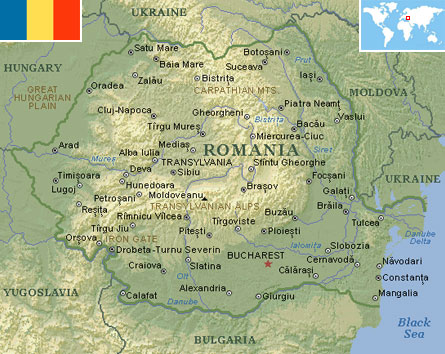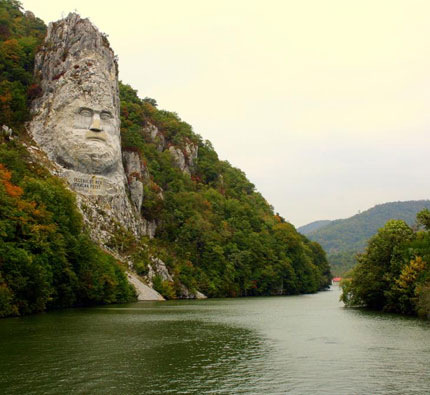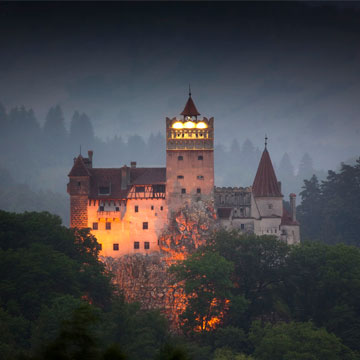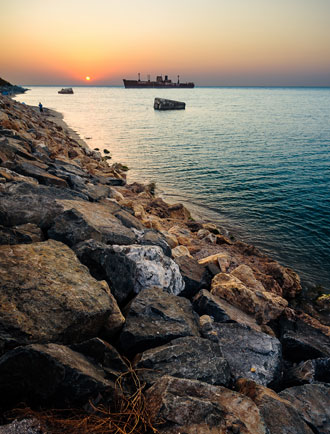Romania
Country statistics

Land area: 88,934 sq miles (230,339 sq km)
Total area: 91,699 sq miles (237,500 sq km)
Population (2011 est.): 21,848,504 (growth rate: -0.26%); birth rate: 9.49/1000; infant mortality rate: 10.73/1000; life expectancy: 74.22; density per sq miles: 207
Capital City: Bucharest
Monetary unit: lei
Languages: Romanian 91% (official), Hungarian 6.7%, Romany (Gypsy) 1.1%, other 1.2%
Ethnicity/race: Romanian 89.5%, Hungarian 6.6%, Roma (Gyspy) 2.5%, Ukrainian 0.3%, German 0.3%, Russian 0.2%, Turkish 0.2%, other 0.4% (2002)
Religions: Eastern Orthodox (including all sub-denominations) 86.8%, Protestant (various denominations including Reformate and Pentecostal) 7.5%, Roman Catholic 4.7%, other (mostly Muslim) and unspecified 0.9%, none 0.1% (2002 census)
Country introduction

Romania is a country located at the intersection of Central and South-eastern Europe, bordering on the Black Sea. Romania shares a border with Hungary and Serbia to the west, Ukraine and Moldova to the north-east and east, and Bulgaria to the south.
Romania's natural landscape is almost evenly divided among mountains (31%), hills (33%), and plains (36%). These varied relief forms spread in the shape of an arch from the Carpathian Mountains over 965 km (600 miles) to the Danube delta. These mountains are generally of low height and are divided into three divisions namely the Eastern Carpathians, the Southern Carpathians or Transylvanian Alps, and the Western Carpathians.
Beyond the Carpathian Mountains the plains extend to the south and the west. The lower Danube plain is separated by the Olt River. On the east of the river there is the Romanian plain and on the west there lies the western plain. This plain is very fertile for the agricultural use.
Some of the important rivers of Romania are Mures, Somes, Arges, Siret, Lalomita, Prut and the Olt. The Danube is by far the most important one, which is used both for transportation and the generation of hydro-electricity. Mineral springs with therapeutic properties have been long in use at Baile Herculane, Baile Felix, Tusnad, Vatra Dornei, Olanesti, Calimanesti, etc. Many health resorts were built in these areas.
The culture

Romanians are naturally hospitable people and are always eager to share stories of their village with travellers passing-by. People who live in small towns and villages outside the cities have changed their lifestyle very little over the years. It is not uncommon for villagers to use horse-drawn carriages as their main means of transport.
The rich Romanian traditions and culture mostly stemmed from the Dacians, who once occupied the area as far as 2,000 years ago along with the Romans, who were among the other influences. Also the belief in vampires which popularized in the late 1800s by the story of Dracula has a long history in Romanian folk culture and is still followed in more traditional rural communities. Sights throughout Romania, like the Bran Castle, are associated with Vlad the Impaler, and tours and events focus on his legacy.
Despite strong Austrian, German, and especially French influence, many of Romania's great artists, such as the painter Nicolae Grigorescu, the poet Mihai Eminescu, the composer George Enescu, and the sculptor Constantin Brancusi, drew their inspiration from Romanian folk traditions. Poetry and the theater play an important role in contemporary Romanian life. Classic Romanian plays, such as those of Ion Luca Caragiale, as well as works by modern or avant-garde Romanian and international playwrights, find sophisticated and enthusiastic audiences in the many theaters of the capital and smaller cities.
Easter is the most important holiday in Romania for Eastern Orthodox Christians. Its observation begins on Palm Sunday, when palm leaves or pussy willows are brought home from church. This is followed by the forty-day period of atonement of Lent (fasting), which ends on Good Friday. Easter Sunday, three days later, is celebrated with feasting and a midnight mass. Special folk arts created during these celebrations are the elaborately decorated Easter eggs and painted glass, which are sold in many markets and vendors throughout the country. Romanians also celebrate Christmas, which begins on 6 December (Saint Nicolas's Day) with family feasts. On the night before Christmas, young people wear costumes and perform colinde, traditional songs expressing hopes for good luck. Romanian festivals feature brightly ornamented costumes and traditional folk arts, including dance, music, wood-carving, ceramics, skilfully woven carpets, pottery and embroidered household decorations, which are some elements of traditional Romanian culture.
Attractions & landmarks

The varied and diverse attractions of Romania are spread in all the cities and counties but the largest historical and archeological sites in the country can be found in the main capital of Romania.
There are many architectural features in Bucharest, which have been inspired by French architecture. There are some awe-inspiring monuments, a rich and active nightlife and numerous restaurants serving exquisite cuisines. There are also many museums, churches, cathedrals and palaces in Bucharest. Some major attractions include The Palace of the Parliament, which is the largest building in Europe and the second-largest in the world. It was built in 1980 during the reign of Communist dictator Nicolae Ceausescu and houses the Romanian Parliament and the National Museum of Contemporary Art. Arcul de Triumf. another well-known landmark, was built in 1935 and modeled after the French Arc de Triomphe in Paris. It is also worth visiting The Romanian Athenaeum, a concert hall in the centre of the Romanian capital, which was opened in 1888 to serve the purposes of the Romanian Atheneum Cultural Society founded in 1865.
Attractions in Romania also consist of the Danube Valley, Wooden Churches of Maramures, Historic Center of Sighisoara, the Black Sea Coast, villages in Transylvania and Churches of Moldavia. The Danube Valley is not only famous for its river and cruises, but the valley is home to several species of flora and fauna. It is one of the best maintained and preserved places in Romania. There are various churches and cathedrals in Transylvania, which are the main attractions of the place. Romania is a country with medieval architecture and forts are an integral part of Romanian architecture. The small villages of Romania is a beautiful land of scenic views and picturesque countrysides.
Another very big attraction is the Black Sea Coast, which stretches out for 246 km (153 miles) and has fine, soft sand and safe, gently sloping beaches. The water of the Black Sea has a low salinity in comparison with other inland seas (only 17%) and there is a virtual absence of tides and currents. The Romanian Black Sea Coast is a blend of old and new. Many historical sites, ancient monuments, traditional villages together with the traditional culture of the region, which is a mixture of Romanian, Greek, Macedonian and Turkish influences, coexist with all the modern facilities offered by the resorts.